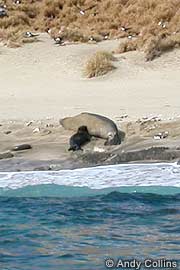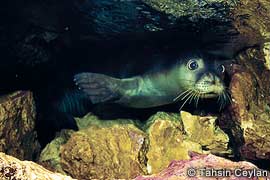

 |
||
 |
||
Vol. 6 (2): December 2003 |
Download this page
|
|
Warped prioritiesA few weeks after reading about monk seal projects being run on starvation rations, I heard on the news today of Keiko the orca whale’s death, star of those Free Willy movies. A sad event, OK, but what is even sadder is the money thrown at that project to rescue a single individual whale, fly it to Iceland, teach it to eat live fish again and rejoin its family pod – which it never managed anyway. Twenty million dollars, according to CNN and running costs of $500,000 per month. Excuse me, perhaps our priorities are a little warped? According to your site, Europe’s most endangered marine mammal gets chickenfeed or nothing at all. I have a suggestion. Why not call the governments and those organisations to account? Publish a list every issue, detailing how much each is committing to monk seal conservation and for what. Then at least we will know the score. Call them “league tables”. – J.J. Wilcox
|
 |
|
|
A monk seal and pup on O‘ahu, Hawai‘i. |
As reported in previous issues of TMG, sightings and births of monk seals on the main, inhabited Hawaiian Islands continue to increase, posing something of a dilemma for scientists and conservationists [Monk seals colonise the Main Hawaiian Islands, TMG 6 (1): 2003].
A spate of recent human encounters with inquisitive or frolicsome seals led the US Department of Land and Natural Resources to issue a news release on 30 October 2003 [Do Not Feed or Interact with Hawaiian Monk Seals, ![]() 124KB], “reminding boaters, fishermen, swimmers and others, that it is against state and federal laws to feed or harass endangered Hawaiian monk seals. It is harmful to the animals and dangerous to people.”
124KB], “reminding boaters, fishermen, swimmers and others, that it is against state and federal laws to feed or harass endangered Hawaiian monk seals. It is harmful to the animals and dangerous to people.”
A 2 year old male seal designated RM-32, charged with nipping and groping swimmers on the Big Island and on Maui, was eventually banished, and flown 800 miles away on a Coast Guard C-130 Hercules transport to the former nuclear test site of Johnston Atoll [see Hawaiian Press Watch, this issue].
Further information
Baker J.D. and T.C. Johanos. 2004. Abundance of the Hawaiian monk seal in the main Hawaiian Islands. Biological Conservation 116 (1): 103-110. [Abstract]
MMC/NMFS. 2003. Workshop on the management of Hawaiian monk seals on beaches in the Main Hawaiian Islands. 29-31 October 2002, Kauai Sheraton Resort Koloa, Kauai, Hawaii. Cosponsored by Marine Mammal Commission, National Marine Fisheries Service, Hawaii Division of Aquatic Resources. Final Report, January 2003: 1-58. [![]() 201KB]
201KB]
I’m in Almeria, Southern Spain… actually in a little place called Mojacar. I’m doing some work with the local marine animal rescue group who are also part of Ecologists in Action. They are interested in the monk seal and I was wondering if there are any plans for reintroduction into this part of the Med?
– Doug Cartlidge, Almeria, Spain
![]() Editor’s reply:
Editor’s reply:
There are several important points to remember when considering the possible reintroduction of Monachus monachus into such historically occupied sites. One: the monk seal is extinct in Spain. Two: Artificial or forced reintroduction, although still a dream of the mechanistically-minded, has yet to achieve a consensus of scientific opinion, and for a variety of reasons:
Three: For all the above reasons, only steps that encourage the natural recolonisation of the species have so far been approved by the monk seal conservation community. Indeed, the UN Action Plan for the Management of the Mediterranean Monk Seal [![]() 18KB] and related UNEP/MAP conference resolutions call upon countries to protect historically-occupied habitat in the hope that this will encourage stragglers or migrant individuals to become permanent residents.
18KB] and related UNEP/MAP conference resolutions call upon countries to protect historically-occupied habitat in the hope that this will encourage stragglers or migrant individuals to become permanent residents.
While the idea of translocation continues to cause controversy [see Mystery at RAC/SPA, this issue and Monk Seal reintroduction in Israel, TMG 5 (2): 2002], consensus opinion is not entirely elusive.
Published in 1998, the Mediterranean Monk Seal – Conservation Guidelines [![]() 955KB] synthesizes scientific thinking on a range of management issues, including translocation and captive breeding. It was subsequently endorsed by 78 marine mammalogists and other professionals involved in the study and conservation of the monk seal. The multilingual edition – in English, French, Greek, Spanish and Turkish – is available in the Monachus Library.
955KB] synthesizes scientific thinking on a range of management issues, including translocation and captive breeding. It was subsequently endorsed by 78 marine mammalogists and other professionals involved in the study and conservation of the monk seal. The multilingual edition – in English, French, Greek, Spanish and Turkish – is available in the Monachus Library.
Is there any research done on the monk seal that involves scuba diving?
– Rob Fraser-Thompson, United Kingdom
![]() Editor’s reply:
Editor’s reply:
Scuba diving does not play a significant role in Mediterranean monk seal research. There are, however, exceptions to the rule – for example, when diving is required for mapping caves with underwater entrances. Turkey’s leading monk seal research and conservation organisation, the Mediterranean Seal Research Group (AFAG) was actually founded by scuba diving members of the Underwater Research Society (SAD), and they continue to apply their diving skills when required.
One of the most important reasons that scuba diving only figures infrequently during research is that the Mediterranean monk seal is highly susceptible to disturbance. As such, scientific investigations are normally geared towards non-invasive methods.
Recognising the risk of human disturbance to the species, Turkish law expressly prohibits entry into seal caves.
I see from your excellent web site/journal that you have referenced my paper with Professor I.L Boyd in Oryx, however you have recorded my name incorrectly – I am M.P. Stanfield.
Incidentally, we are continuing our investigations into the possible existence of the Caribbean Monk Seal in view of our findings in N.E. Jamaica and N. Haiti. A further field trip is in the planning stages for 2005. In 1999, after the publication of the ‘Circumstantial evidence for the existence of Monk Seals in the West Indies’, we visited E. Cuba with Cuban scientists going to areas which have hitherto been ‘off limits’ and could find no evidence of the seal’s existence in this area.
– Mike Stanfield, United Kingdom.
![]() Editor’s note:
Editor’s note:
The typo, which recorded Dr. Stanfield’s name as “Standford” in the Monachus Profiles section has been corrected.
For further information on the search for the extinct(?) Caribbean monk seal, Monachus tropicalis, readers are advised to check out the following publications:
Boyd I.L. and M.P. Stanfield. 1998. Circumstantial evidence for the presence of monk seals in the West Indes. Oryx 32 (4): 310-316.
Lavigne D. 1998. Caribbean Monk Seals – Are they Extinct? The Monachus Guardian 1 (2): December 1998.
Last week [11th-17th May 2003] we saw a seal in the port of Kas [on the Anatolian coast of Turkey, adjacent to the Greek island of Kastellorizo], at about 23.00. We were told that one sees a seal there from time to time, but never before inside the port. The animal did not appear to be very shy.
What is your information about monk seals in this area?
– Ingo Palm, Germany
![]() Harun Güçlüsoy, SAD-AFAG, Foça, Turkey, replies:
Harun Güçlüsoy, SAD-AFAG, Foça, Turkey, replies:
 |
|
|
A juvenile seal photographed in the Kas area in October 1997. |
We will be delighted to add your observation to our database where we store our monk seal sightings records. Concerning seals around Kas, we searched the records in our dbase file, and so far we have 16 monk seal sightings, of which 8 are our own records from 1994 to 2002. We also have two records from the harbour of Kas in 1996 and 1997 respectively.
A juvenile seal observed and photographed by one of our volunteers reveals that breeding still occurs around this region. Threats to the species in this region are mainly tourism related, including cave diving, disturbance and coastal development.
I heard of a population of monk seals in Santorini (Thira) [a popular tourist island in the southern Cyclades, Aegean sea]. Is it true and if so, do you have any more information on this issue?
– Dr. Onno Gross, Hamburg, www.deepwave.org.
![]() Stella Adamantopoulou, MOm, Athens, Greece, replies:
Stella Adamantopoulou, MOm, Athens, Greece, replies:
Unfortunately there is limited information on seal sightings in Santorini (less than 10 reports). However, the species still exists around the coastline of the island. The most recent observation was in February 2001.
The editor reserves the right to edit letters for the sake of clarity and space
Copyright © 2003 The Monachus Guardian. All Rights Reserved |